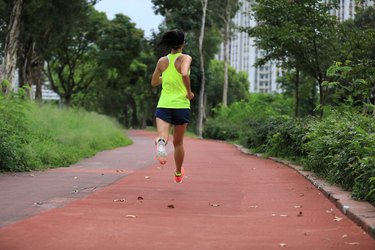
Physical exercise, along with emotional arousal and other stresses on the body, is often associated with increased skin coloration in light-skinned people.
In most contexts, working out is associated with being "red in the face," especially when short, intense bursts of activity are involved. Nevertheless, under certain conditions and in the right environment, exercise can have the opposite effect on your complexion.
Video of the Day
Video of the Day
Tip
Your face can turn white after exercise when your blood supply is redirected to your muscles; or more seriously, it could be anemia.
Blood Supply Redistribution
The most common reason your skin turns white while you're exercising is that much of your blood supply is redirected to your muscles. Blood that normally flows through the small vessels close your skin's outer layers is instead pumped through the muscles to meet their increased oxygen needs. This effect, known as shunting, is more common in cold weather when less blood needs to stay close to your body's surface to rid it of excess heat and when you are exercising at a high intensity, which maximizes the shunting effect.
Iron Deficiency or Anemia
Many exercisers become deficient in body iron stores, which, if it progresses to a decrease in hemoglobin, is classified as anemia says MedlinePlus. Hemoglobin is the portion of red blood cells, or RBCs, that binds with oxygen and allows the RBCs to carry oxygen to working muscles.
Runners and other endurance athletes are especially susceptible because of iron losses in sweat and — in runners and joggers — as a result of mechanical impact stresses. Besides pale skin, symptoms include fatigue, irritability and malaise. Oral iron supplements, as suggested by your physician, may be necessary to restore iron levels to their normal values.
Pernicious Anemia Disorder
Low iron is not the only nutrient deficiency that can wreak havoc on your RBCs. The National Institutes of Health reports that low levels of vitamin B-12 can cause a disorder known as pernicious anemia. As the name suggests, the symptoms of pernicious anemia resemble those of iron-deficiency anemia, with white skin, dizziness, fatigue and dyspnea usually present.
If allowed to persist, pernicious anemia can cause derangements in your nervous system, such as tingling in the extremities and memory loss. Treatment includes the addition of foods rich in vitamin B-12 dietary and oral B-12 supplements. In more severe cases, repeated injections of the vitamin are necessary.
Cold-Induced Skin Damage
Most every resident of higher latitudes has experienced some form of frostbite or cold-induced skin damage. The McKinley Health Center at the University of Illinois describes four distinct stages of this condition. The first, called "frostnip," features a whitening of the skin and a "pins and needles" sensation.
The next involves numbness and skin that feels wooden to the touch. The third is more serious and includes blistering, with the exudation of clear or milky fluid. In the fourth and most severe type, the skin becomes gangrenous and turns black, indicating tissue death. If you exercise outdoors at high latitudes, you should head indoors at the first sign of frostbite to avoid permanent skin loss.